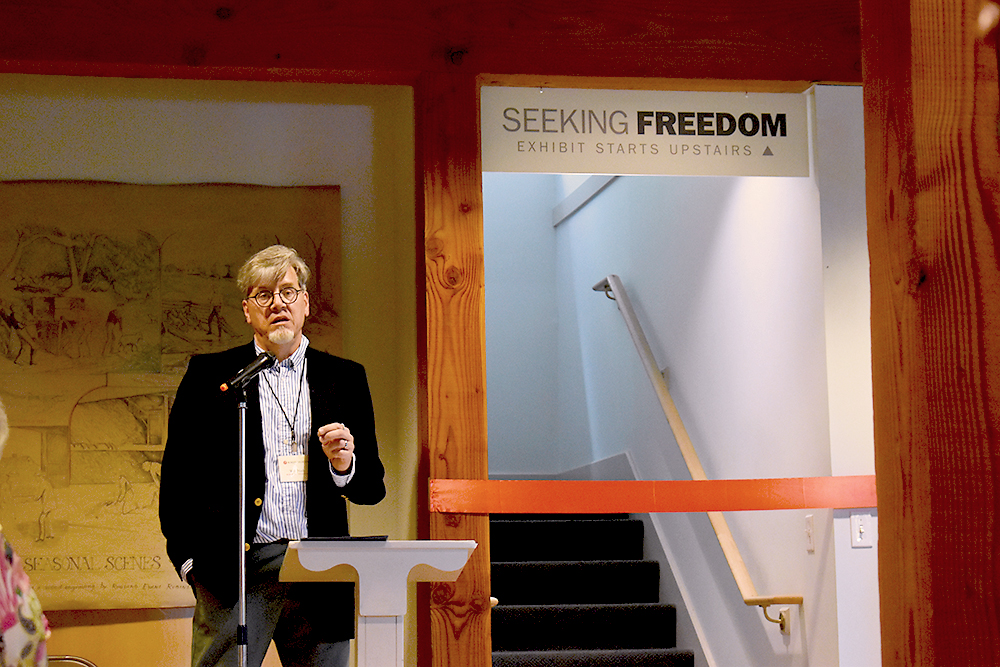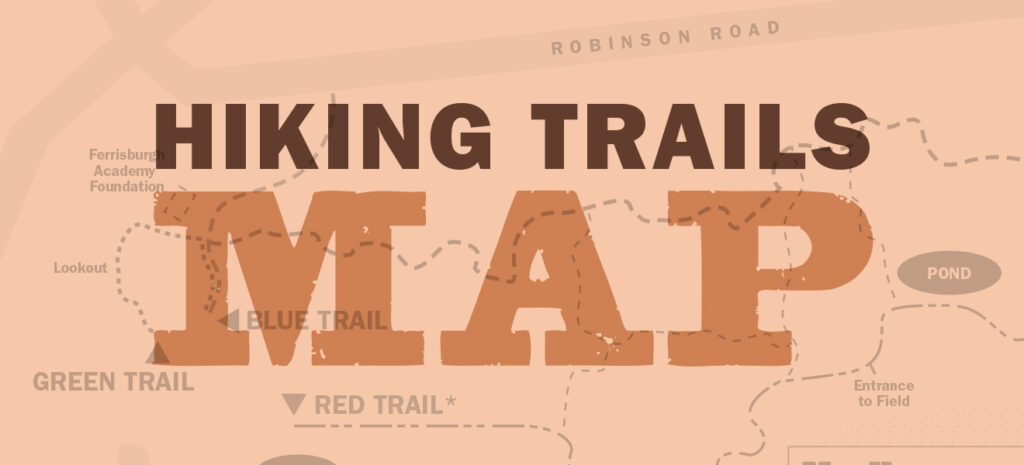Words have power — the opening of Rokeby’s new main exhibition, “Seeking Freedom”

On May 23, 2024, Rokeby Museum opened a new main exhibition on the Underground Railroad.
Seeking Freedom: The Underground Railroad and the Legacy of an Abolitionist Family explores the history of American enslavement, the antislavery movement, and the Robinson family’s complex history as abolitionists. The development of this new exhibition took place over several years, with hours of research, review, and editing going into the final display. Feedback on what the public would like to see in the new exhibition was gathered over several years, with many expressing their wish to have a visual and family-friendly space.
Over 60 people attended the opening event, and three speakers were asked to share their part in the exhibition. Dr. Lindsay Varner, Executive Director of Rokeby Museum, Ethan Avendano-Lawrence, and Dr. William Nash. Below are the remarks given by Dr. Varner and Dr. Nash.
Welcome, and thank you for joining us today to celebrate the opening of Rokeby’s newest UGRR exhibition, Seeking Freedom: The Underground Railroad and the Legacy of an Abolitionist Family.
First and foremost, I must thank everyone who helped with this project. This was a team effort with many volunteers serving on an advisory committee, painting galleries, reading draft text, and reviewing design. He’ll hate this, but I must single out Steve Wetherby for his countless hours designing and installing the exhibition. Over the past few months, we have worked weekends, nights, and this week, especially well past closing hours, to ensure this space was completed, and this was all done as a volunteer. Steve, I love working on exhibitions with you. Thank you for all you do for Rokeby.
Seeking Freedom is the culmination of years of planning. When I first began at Rokeby, I met with volunteers, staff, and trustees, and they all said the same thing to me: “You should start thinking about updating the permanent exhibition in the museum; it’s almost 10 years old.” I especially remember walking through the exhibition with Elise Guyette, and her challenging me to think about the next phase of the exhibition. That meeting stuck with me throughout the planning for Seeking Freedom, so it is fitting that Elise will cut the ribbon to open the exhibit today.
Updating the exhibition was a little intimidating. There is a deep love of the history and stories presented in Free & Safe: The Underground Railroad in Vermont. I, too, enjoyed the exhibition and frequently spoke about how impressed I was with its interpretation of the UGRR and enslavement in the U.S. But in the ten years since it was installed, so much has been learned, and feedback from the public showed us they wanted to engage more with the history at Rokeby and learn how it intersects with what is happening in our communities today.
This new exhibition, Seeking Freedom, is a testament to our collective growth and understanding of history and its impact on our communities today.
This new exhibition, Seeking Freedom, is a testament to our collective growth and understanding of history and its impact on our communities today. It also speaks to the thousands of visitors who come to Rokeby each year. We heard their suggestions and have added new stories, updated the history, and created a space to learn for people of all ages.
Going forward, one thing I want to change is how to label this exhibit. For years, Rokeby called Free & Safe its permanent exhibition. It is not permanent and as we continue to research and address social and racial justice in our country, Seeking Freedom will be updated and adapted to better tell the American story. Like so many museums across the country, we are finding ways to share hidden and missing stories at Rokeby and to create a more complete and inclusive American story. So I welcome you to our MAIN exhibition, which will be updated (although on a smaller scale than this update) throughout its lifetime at the Museum.
We could not have done this exhibition without the support of donors and grants. The William G. Pomeroy Foundation challenged us last year to raise $10K, and they would match those funds. The Museum held its first Music at the Museum event a year ago, and on that night, we reached our goal. We also could not have done this without the support of Senator Bernie Sanders. Today, there is an outreach representative from his office with us, and I will hand it over to Ethan [Outreach Representative from the office of Senator Bernie Sanders] to say a few words.
— Lindsay Varner, Executive Director, Rokeby Museum, May 23, 2024
Good afternoon — it’s wonderful to see you all here gathered to celebrate the opening of the new main exhibit. What a great day this is for Rokeby!
Before I say any more, I want to congratulate Lindsay, Tucker, Steve, and everyone who worked to bring the idea of this exhibit to fruition. Lindsay and I have been talking about updating the Underground Railroad exhibit almost from the moment we met, and her leadership and dedication made this possible. Among the many things she has done included the grant seeking that led to our securing the generous funding that Senator Sanders championed us for — so can we please acknowledge both her and Ethan once again?
Lindsay asked me to say a few things about why updating the Underground Railroad exhibit is so important, which I am happy and honored to do. For me, the start of answering that question boils down to two words: history and historiography.
For the purposes of clarity, I’m going to define history as events that happened in the past. Seen in those terms, then, history is a relatively fixed thing.
The Robinson family worked for the abolition of enslavement here at Rokeby, and among the ways they did that was making a space for so-called “fugitive slaves” to live, work, and be compensated for their labor. Over the years, we have learned more about the particulars of how they made that space and who some of the “fugitives” were — but the history hasn’t changed, just the breadth and depth of our knowledge about it.
“If ‘history’ means ‘events that happened in the past,’ what does historiography signify? Well, by one definition, historiography is ‘how we study and make sense of those events.‘”
If “history” means “events that happened in the past,” what does historiography signify? Well, by one definition, historiography is “how we study and make sense of those events.” Unlike history, historiography is not fixed — in fact, it’s perpetually evolving, because it’s constantly being shaped and re-shaped by the cultural context in which it occurs. This evolution takes myriad forms, and some of the most obvious manifestations come in revisions of language. That’s certainly true in the case of what we used to call “slavery” and “fugitive slaves” and now call “enslavement” and “freedom seekers.”
Now, lest you think I am here to heat up the culture wars, let borrow some language from a panel in the Orientation Gallery of the Owens-Thomas House & Slave Quarters Museum in Savannah, Georgia to explain why these revisions are so important.
“Words have Power. They express meanings, ideas, and relationships. They impact how we relate to the past and one another. As we share this history, we strive to use words that are empathetic to those whose history has been marginalized.“
“Words have Power. They express meanings, ideas, and relationships. They impact how we relate to the past and one another. As we share this history, we strive to use words that are empathetic to those whose history has been marginalized. For example, we use phrases like enslaved woman, rather than slave. The noun slave implies that she was, at her core, a slave. The adjective enslaved reveals that though in bondage, bondage was not her core existence. Furthermore, she was enslaved by the actions of another. Therefore, we use terms like enslaver, rather than master, to indicate one’s effort to exert power over another.”
Ultimately, then, these terms reinforce the idea of people’s humanity rather than reducing them to the conditions forced upon them.
These convictions, that “words have power” and that they “impact how we relate to the past and one another” have been central to creation of this exhibit — guiding the work of our ad hoc committee on exhibit design; inspiring Lindsay and Tucker through the countless hours that they have put in to craft the new exhibit; and informing my Middlebury College students’ analysis and reviews of the old exhibit.
One word on that, which was one of my favorite parts of my involvement in this process. Lindsay and I collaborated to bring my “Reading Enslavement and Abolition” students to the museum after its closing last October. After a preparatory conversation with Lindsay, they went in attuned to everything from the lighting to the arrangement to the text on the walls. They were happy to be able to share their perspectives on the old exhibit’s strengths and weaknesses; I was happy for them to have a real-time, real-life illustration of historiography as a dynamic process; and Lindsay and I were thrilled to connect them with Rokeby and its mission. After the semester was over, several students remarked to me that the museum visit was the most meaningful part of the class — and I like to think that their reflections on what they saw will stick with them for years to come. I know that we’ll be feeling the benefit of that process here at Rokeby for the foreseeable future.
Because my remarks are the final impediment to the ribbon cutting, I’ll wrap this up. And I’ll leave you with this — this new exhibit not only demonstrates the museum’s awareness of and sensitivity to the evolving historiography of enslavement and freedom seeking; it also puts Rokeby at the forefront of public thought and discussion about a crucial element of our local, state, and regional history. I’m sure we can all agree that’s a great position to be in — now let’s go and see this new exhibit!
— William Nash, Professor of American Studies and English, Middlebury College, Rokeby Museum Board of Trustees, May 23, 2024
 Rokeby Museum
Rokeby Museum







